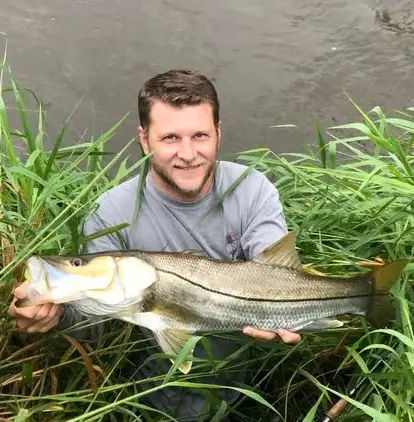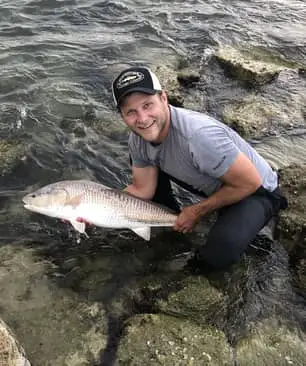It’s no secret that snook prefer warm water, and a cold snap can make the fishing tough.
So where do snook go in the winter? What tactics can you employ to find the snook, and get them to bite during the colder months?
I’ll share with you what I’ve learned after 20 years of snook fishing in Florida.
Table of Contents
- Where Do Snook Go When It’s Cold?
- Do Snook Bite When It’s Cold?
- What Time of Year is Best to Catch Snook?
- What Do Snook Eat in Winter?
- Tips to Catch Snook During Cold Fronts
- Can Cold Weather Kill Snook?
- Do Snook Migrate?
- How Far North Do Snook Go?
Where Do Snook Go When It’s Cold?
Snook, like almost all other fish, are cold-blooded animals. Unlike us warm-blooded mammals, fish are ectotherms, and they cannot stabilize their internal body temperature by themselves.
This means that fish rely on their environmental temperature to stay alive.
Snook are tropical species, and they require the warm waters of the tropical climate they are adapted to. However, Florida is considered subtropical and is subject to harsh winters. As a result, snook must find thermal refuge to survive the cold.

Extended periods of severe cold weather is not good for snook. Fortunately, they will hone in on and find the warmest water around. This gives them the best chance at survival!
Freshwater rivers, canals, and ponds can offer some thermal refuge during the winter.
For example, some river systems in Florida, especially rivers along Florida’s Gulf coast, have natural freshwater springs running into them.
During the cold, snook will find the warmest water around. Some snook go up river into freshwater rivers. Some snook will move with the tides, following the warmer waters coming from offshore.
These freshwater springs have water coming up from the Florida aquifer deep underground. The water in these springs is a constant 72 degrees Fahrenheit (or 22 degrees Celsius) all year round.
This is an example from nature, but snook will hone in on any source of warmth, natural or artificial.
Any unnatural thermal discharge, such as a power plant, will surely attract snook during the winter.
Do Snook Bite When It’s Cold?
Snook fishing in the winter is really fun because they bite well during the day. Fishing on the warmest days of the week is your best bet at a good snook bite in the winter. They will feed best pre-front, the day or two before it gets really cold.
Snook will bite in the winter, but if it’s too cold, they may not have the energy to eat at all until the temperatures warm up again.
What Time of Year is Best to Catch Snook?
Snook can be caught all year round. However, the best snook fishing is during the warmer summer months and early fall. That is when snook spawn, and when baitfish are plentiful.
Personally, I enjoy fishing inshore for snook during the winter and spring, when the weather is nice during the day and the bite is good. Unlike the summertime, when it’s hot and rainy every day, winter and spring weather is pleasant.
In the summer, the bite window is often focused into the crepuscular hours. Snook bite well at sunrise, sunset, and at night.
I love fishing at night for snook after a summer thunderstorm.. The bite window is often short, but fierce!
In the winter however, snook will feed more during the day, because that is when the water is warmest and they have the most energy.

During the rainy season, in the late summer months, I catch many snook at spillways and water control structures up freshwater rivers, creeks and canals.
The heavy rains get the spillways flowing fast and snook come up to feed.
What Do Snook Eat in Winter?
In the winter, there are generally less big baitfish than in the summer. That means snook feed much more on shrimp and smaller baitfish. The winter is a very good time to downsize your presentation.
It’s also a good opportunity to slow down your fishing tactics. Unlike the summer and fall, when snook are feasting on large schools of fish during the mullet run, during the winter snook can be somewhat lethargic.
I’ve had good success with a bucktail jib or flair-hawk jig fished very slowly in the current and bouncing off the bottom.
Tips to Catch Snook During Cold Fronts
The best time to fish is before the cold front. Keep an eye on the barometric pressure, you want to fish when the pressure is low or falling.
If you end up fishing during a cold front (during high pressure) snook fishing will be challenging.
For fishing during a cold front, your best bet is to get some live shrimp. Use a free line, split shot, or Carolina rig with a circle hook. Fish the shrimp in deeper areas, such as bridges, channels, inlets, and passes.
Keep an eye on the shallows too on a sunny day, you might just see some snook warming up in the sun.
In the winter, it’s common to see snook up really shallow, in inches of water, catching the sunlight to warm up! At night, when temperatures drop, they will find deeper water, where the water temperature is more stable.
Can Cold Weather Kill Snook?
Cold weather certainly can and will kill snook! Every year, there are reports of snook floating the morning after a very cold night.
Water temperatures between 43 to 55 degrees Fahrenheit are enough to kill adult snook, and water temperatures between 48 to 57 degrees Fahrenheit is enough to kill juvenile snook.
Do Snook Migrate?
Snook are migratory species. Snook will travel far up rivers to feed, but they must eventually return to saltwater to spawn. All snook species spawn in saltwater, usually at large passes, inlets, or on the beach.
How Far North Do Snook Go?
Today, snook are abundant in North Florida along the Atlantic coast and the Gulf Coast. Each year, there are several reports of snook being caught as far north as North Carolina.
Historically, snook only went as far north as Central Florida, but today an increase in global temperatures have allowed snook to expand their range north.
You May Also Like: How To Identify The Different Types Of Snook (W/Pics!)

Growing up in Florida, I’ve been surrounded by saltwater my entire life…and I love sharing my passion with others.
To learn more about why I started Saltwater Mecca, visit the ABOUT page.
Thank you for reading this article. Browse around & have some fun!